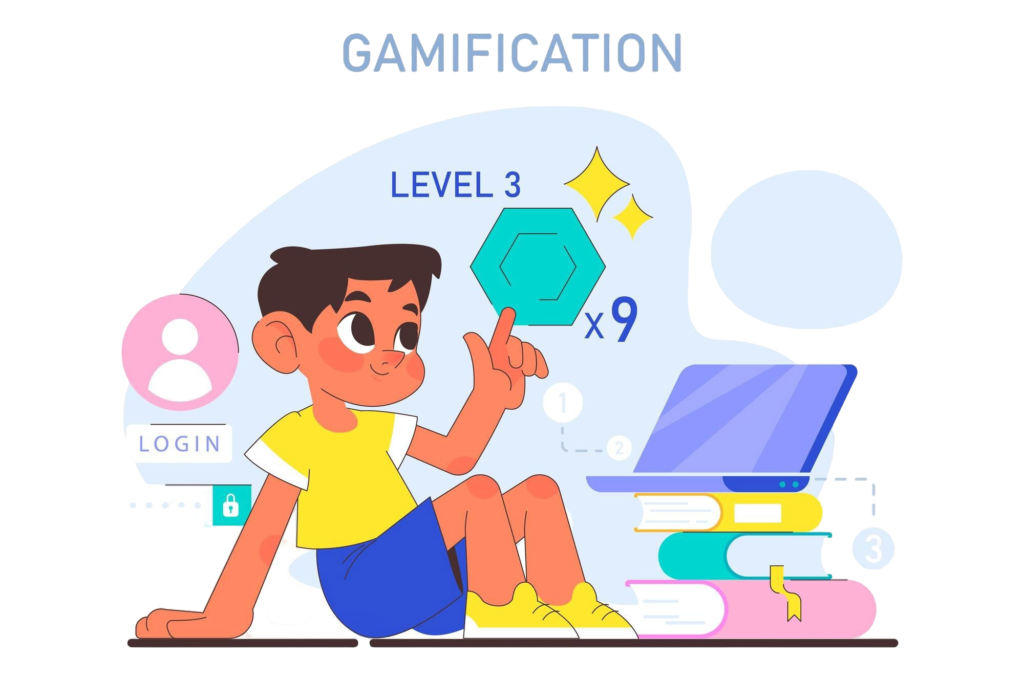


Gamification is the practice of incorporating game-like elements and principles into non-gaming contexts to enhance engagement, motivation, and participation. These game-like elements could be features like point scoring, leaderboards, challenges, and rewards to make activities more interactive and enjoyable. Principles of gamification have been employed in a variety of forms from centuries ago, but with the emergence of modern technology, their application has expanded significantly, especially within professional spaces.
Nowadays, gamification is used across diverse fields including education, online communities, and businesses. Each sector may leverage gamification in different ways, whilst education might involve creating interactive quizzes and competitions in order to facilitate learning. In Business, gamification is used to drive customer engagement on websites, foster online communities, and boost motivation in ecommerce environments.
By transforming tasks into engaging and rewarding experiences, gamification encourages users to interact, share, and collaborate more effectively, ultimately enhancing their overall experience and commitment.
Just as video games captivate players with their competitive elements, engaging narratives, and immersive experiences, gamification harnesses similar principles to make non-gaming activities more compelling. The magic lies in tapping into human psychology and leveraging motivational mechanisms to enhance user engagement.
Here are some key reasons why gamification is so successful:
Humans are naturally driven by our ambitions and desire for progress. We want to see tangible results from our efforts, and gamification facilitates this by allowing us to track our progress. By visualizing our achievements and identifying areas for improvement, gamification keeps us motivated and focused. It transforms abstract goals into concrete milestones, providing continuous feedback and fostering a sense of accomplishment that drives ongoing engagement.
Humans are inherently competitive, and gamification taps into this competitive spirit in a way that motivates without creating discomfort. For instance, Duolingo uses point systems and leaderboards to encourage users to complete more lessons, leveraging friendly competition to boost engagement. But competition in gamification doesn’t have to be limited to leaderboards; it can also include elements of chance or other competitive dynamics tailored to specific business needs.
Collaboration is another powerful motivator. Gamified experiences that require users to work together towards a common goal foster social interaction and enhance engagement. Collaborative elements can make the experience more enjoyable and encourage users to connect with one another.
A fundamental human drive is the pursuit of achievement. Gamification leverages this by incorporating milestones, rewards, and recognition into the experience. Each time users reach a goal or earn a reward, their brains release dopamine, creating feelings of pleasure and satisfaction. This positive reinforcement not only encourages users to continue engaging with the system but also helps build a sense of community. For example, earning VIP status or badges from a brand can make users feel valued and special, reinforcing their connection to the brand.
Gamification revitalizes interactions with brands by injecting novelty, fun, and psychological triggers into the experience. This approach promotes reward-seeking behavior, fuels competition, and fosters community engagement. By understanding consumer psychology and applying gamification principles, businesses can create strategies that are not only entertaining but also effective in building brand loyalty and driving desired consumer actions. In essence, gamification transforms marketing into a dynamic journey, making every interaction with the brand more meaningful and engaging.
With the average consumer’s attention span dwindling to just 8 seconds, it’s a challenge for business owners and marketers to capture and retain their interest. Ecommerce gamification offers a strategic solution by infusing game-like elements and concepts into online retail environments.
By integrating engaging game mechanics into your ecommerce experience, you can create interactive and enjoyable experiences that captivate consumers. Gamification strategies, such as rewards systems, challenges, and interactive content, can make shopping more engaging and fun. This not only enhances customer interaction with your brand but also helps reduce cart abandonment, improve customer retention, and foster stronger brand loyalty.
Incorporating gamification into your marketing strategy turns routine shopping into a dynamic experience, encouraging customers to return, interact more frequently, and build a lasting connection with your brand.
Gamification in ecommerce has become a powerful strategy to engage customers and enhance their shopping experience. Here are some well-known types of gamification used in ecommerce platforms:
Loyalty programs reward customers for repeat purchases and engagement by allowing them to earn points or ‘level up’ through various tiers. As customers advance through these tiers, they unlock rewards such as discounts, exclusive offers, or special privileges. Additionally, earning badges for milestone achievements can further incentivize continued interaction and purchases.
Referral programs motivate customers to refer friends and family by offering rewards such as points, discounts, or cash incentives for successful referrals. This not only helps expand the customer base but also leverages the power of word-of-mouth marketing.
Progress bars, such as those showing progress towards free shipping thresholds, provide customers with a visual representation of how close they are to achieving a reward.
Competitive challenges involve creating time-bound or skill-based competitions where customers can win prizes.
Quizzes and questionnaires can be used to offer personalized product recommendations or discounts based on customer responses. By engaging customers with interactive content, ecommerce platforms can provide tailored suggestions and incentives, enhancing the shopping experience.
Social sharing rewards incentivize customers to share their purchases or experiences on social media platforms. By offering discounts, points, or entries into sweepstakes for social sharing, ecommerce brands can amplify their reach and attract new customers while fostering a sense of community among existing ones.
The benefits of ecommerce gamification are substantial and multifaceted. Here’s a closer look at how gamification can benefit your ecommerce strategy:
Gamification fosters brand loyalty by creating engaging and rewarding experiences for customers. Through loyalty programs and achievement-based rewards, customers are incentivized to return and make repeat purchases. By consistently providing value and recognition for their loyalty, brands can cultivate a dedicated customer base that is more likely to choose their products over competitors, resulting in sustained revenue and brand advocacy.
Effective gamification strategies significantly boost customer engagement by creating interactive and enjoyable shopping experiences. Features like progress bars, in-app games, and personalized challenges can keep customers actively involved and reduce bounce rates. By curating personalized experiences and offering incentives for engagement, brands can encourage customers to spend more time on their site or app, leading to increased interaction and a deeper connection with the brand.
Understanding your customers is crucial for maximizing the benefits of gamification. We recommend leveraging Dashda to enhance your data visualization capabilities, which can support informed decision-making and provide deeper insights into customer behavior. By using these tools, you can better understand your audience and optimize your gamification strategies for greater impact.
Gamification enhances the overall customer experience by making shopping more enjoyable and rewarding. By incorporating elements such as badges, rewards, and interactive features, brands can improve their image and foster positive perceptions among consumers. These enhanced experiences can lead to favorable word-of-mouth marketing, as satisfied customers are more likely to share their positive experiences with others, thereby strengthening the brand’s reputation and community relationship.
Gamification is particularly effective in appealing to younger generations, such as Gen Z, who are drawn to dynamic and interactive experiences. By integrating gamified elements that resonate with this demographic, brands can attract new customers and establish lasting relationships. Engaging and relevant gamification strategies help create a strong connection between customers and the brand, encouraging new shoppers to remain loyal over time.
Increased customer engagement through gamification directly impacts sales. When customers are more involved and motivated by rewards and interactive features, they are more likely to revisit the brand and complete purchases. By making the shopping experience more engaging and enjoyable, brands can boost customer retention, drive repeat purchases, and ultimately enhance sales performance. Gamification transforms the shopping journey into a more compelling and rewarding experience, leading to higher conversion rates and increased revenue.

Gamification enhances engagement and motivation by integrating game-like elements into non-gaming contexts. In ecommerce, it transforms routine interactions into enjoyable experiences, boosting customer loyalty, increasing engagement, and improving sales. Additionally, gamification strengthens marketing efforts by creating interactive and memorable brand experiences that capture consumer attention and drive word-of-mouth referrals. By making tasks more compelling and rewarding, gamification fosters deeper connections between brands and their customers, leading to a more effective and engaging marketing strategy.
For those seeking to elevate their engagement and marketing efforts, MOST 2414 offers valuable insights and tools to enhance your B2C strategy. Whether you need assistance with data analysis, campaign management, or strategic planning, these resources can help advance your ecommerce platform. We look forward to seeing more innovative uses of gamification!




Thailand’s e-commerce market is on an exciting growth trajectory, expected to hit 750 billion THB by 2025. With digital adoption soaring and platforms like Shopee and Lazada driving massive sales, brands are doubling down on ads, KOLs, and personalized strategies to stay ahead. Ready to tap into this booming digital economy?

What are Fulfillment Centers? A fulfillment center is a specialized warehouse where products are stored, processed, and shipped to customers. Acting as a third-party logistics

Driving eCommerce Growth with Purchase Incentives Customer Purchase Incentives: the Key to eCommerce Growth The eCommerce industry is growing fast, thanks to new technology and
Customer loyalty drives long-term success in e-commerce by creating deep emotional connections with your brand. This article explores various types of loyalty and practical strategies